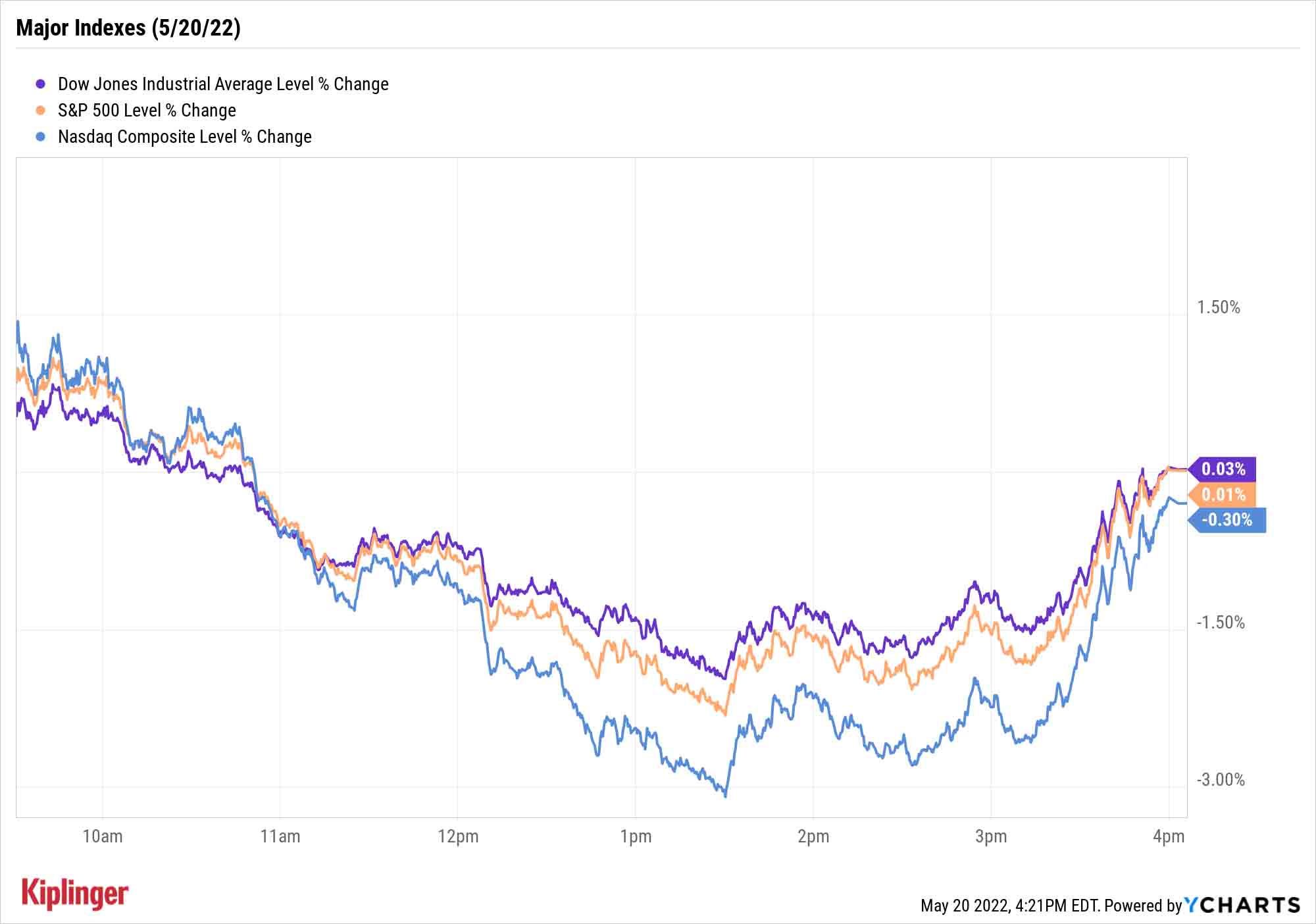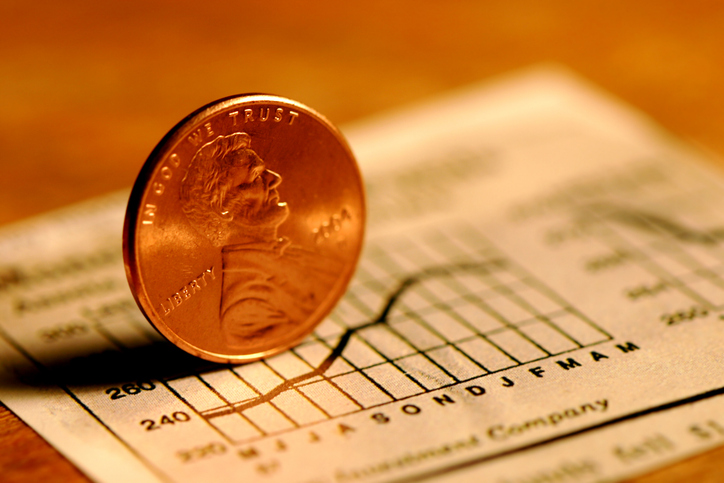Stock Market Today: S&P 500 Narrowly Escapes Bear Territory
The S&P 500 was on pace Friday to finish more than 20% below its January record highs, but a late recovery kept the bear at bay for at least one more session.


The S&P 500 made its closest brush with a new bear market yet, falling more than 20% from its all-time highs during Friday's intraday action before reversing course and actually finishing with a marginal advance.
Specifically, the 500-company index dropped as low as 3,810 – well below the 3,837 level that would mark a 20% drawdown from its Monday, Jan. 3, record highs and put it in an official bear market – but rebounded late in the session to eke out a gain of less than a point, to 3,901.
Among the stocks weighing on the market Friday was Tesla (TSLA, -6.4%), which sank to its lowest level since August 2021 following a Business Insider report claiming that CEO Elon Musk's privately held SpaceX "paid a flight attendant $250,000 to settle a sexual misconduct claim against Musk in 2018." Musk decried the article as "political," but it nonetheless acted as the cap on a difficult week for Tesla, which was just kicked out of the S&P 500's ESG index and is facing COVID lockdown headaches at its operations in China.
From just $107.88 $24.99 for Kiplinger Personal Finance
Become a smarter, better informed investor. Subscribe from just $107.88 $24.99, plus get up to 4 Special Issues

Sign up for Kiplinger’s Free Newsletters
Profit and prosper with the best of expert advice on investing, taxes, retirement, personal finance and more - straight to your e-mail.
Profit and prosper with the best of expert advice - straight to your e-mail.
Meanwhile, Deere (DE, -14.1%) was clobbered despite topping both sales and earnings forecasts and raising its full-year profit outlook. The major criticism of its report? The farm-equipment manufacturer's sales outlook relies on having a strong second half of 2022, which isn't a certainty.
The Dow, like the S&P 500, closed with a marginal gain to 31,261. The Nasdaq declined 0.3% to 11,354 but finished well off its intraday lows.
Dan Wantrobski – the technical strategist and associate director of research at Janney Montgomery Scott who said earlier this week that he was "encouraged" by Wednesday's washout – notes that while this drawdown might have lower to go, longer-term investors can begin sharpening their knives.
"At 3,800, we do believe that the S&P 500 resides in a price range (3,600-4,000) that can lead to some attractive returns over the coming years," he says." He's not calling a bottom for short-term traders, but "investors who hold a long-term view can start to deploy sideline cash in small increments and build long positions for the intermediate- to longer-term timeframe."

Other news in the stock market today:
- The small-cap Russell 2000 declined 0.2% to 1,773.
- U.S. crude oil futures gained 0.4% to settle at $110.28 per barrel.
- Gold futures ended the day unchanged at $1,842.10 an ounce.
- Bitcoin put together a small afternoon relief rally but still finished down $29,265.24. (Bitcoin trades 24 hours a day; prices reported here are as of 4 p.m.)
- Deckers Outdoor (DECK) jumped 12.6% after the maker of Ugg boots reported earnings. For its fiscal fourth quarter, DECK reported earnings of $2.51 per share on $736.0 million, up 113% and 31.2%, respectively, year-over-year. Both figures easily surpassed analysts' expectations, as well. "The company was able to offset supply chain disruptions by leveraging SG&A [selling, general and administrative expenses] in the quarter," says CFRA Research analyst Zachary Warring, who upgraded the retail stock to Buy from Hold. "The company continues to repurchase shares aggressively while maintaining a debt free balance sheet. We see this as an attractive entry point for shares as the company continues to execute and grow its HOKA brand well over 25% annually."
- Ross Stores (ROST) followed in the footsteps of fellow retailers Walmart (WMT) and Target (TGT), plunging in the wake of its quarterly results. Shares spiraled 22.5% after the off-price apparel and home fashions retailer reported lower-than-expected earnings and revenue in its first quarter (97 cents per share actual vs. $1.00 per share est.; $4.3 billion actual vs. $4.5 billion est.), while same-store sales slumped 7% over the three-month period. However, the "big news from ROST's first-quarter earnings report was the company lowered its fiscal 2022 earnings per share guidance to $4.34-4.58 vs. $4.71-$5.12 prior and the Street's $5.01 view," says UBS Global Research analyst Jay Sole (Neutral). "The midpoint of the new range is 8% below ROST's full-year 2021 earnings per share and 3% below its full-year 2019 result." Sole adds that he does not believe today's pullback represents a buying opportunity, and that more guidedowns could be in store as inflation negatively impacts lower-income consumer demand. Quarterly results from retailers will continue to be in focus next week, with Best Buy (BBY) and Dollar General (DG) among the many names on the earnings calendar.
Make Your Portfolio Pay You Every Month
Regular readers of Closing Bell will note that this week, we've been pounding the table about the role dividends can play in helping investors absorb volatile downturns like the one we've suffered in 2022.
We're not alone. Several strategists suggest loading up on dividend stocks in the current environment, including Gargi Chaudhuri, head of iShares investment strategy. "We see dividend stocks as an alternative source of quality, offering outperformance over the broad market, attractive yield for income, and diversified exposure to sectors benefiting from the current macro regime of high inflation and slowing growth," she says.
Most of our recommendations across the week have focused on dividend growth – namely, the S&P 500 Dividend Aristocrats, as well as their counterparts in Canada and Europe. That said, investors more interested in high current yield might find that the Aristocrats are a bit stingy. The ProShares S&P 500 Dividend Aristocrats (NOBL) exchange-traded fund, for instance, yields just 2% at current prices.
Those looking to load their cart with juicier yields might be better off eyeballing a different cohort: monthly dividend payers. Most U.S. dividend stocks tend to pay on a quarterly basis, but there are a select group of equities and funds that conveniently pay you just as frequently as you receive your bills – that is, once each month. Many of these monthly payers also tend to come from special classes, such as real estate investment trusts (REITs) and business development companies (BDCs) that pay much higher dividends than your average blue-chip stock.
Read on as we review a dozen of these generous monthly dividend names.
Profit and prosper with the best of Kiplinger's advice on investing, taxes, retirement, personal finance and much more. Delivered daily. Enter your email in the box and click Sign Me Up.
Kyle Woodley is the Editor-in-Chief of WealthUp, a site dedicated to improving the personal finances and financial literacy of people of all ages. He also writes the weekly The Weekend Tea newsletter, which covers both news and analysis about spending, saving, investing, the economy and more.
Kyle was previously the Senior Investing Editor for Kiplinger.com, and the Managing Editor for InvestorPlace.com before that. His work has appeared in several outlets, including Yahoo! Finance, MSN Money, Barchart, The Globe & Mail and the Nasdaq. He also has appeared as a guest on Fox Business Network and Money Radio, among other shows and podcasts, and he has been quoted in several outlets, including MarketWatch, Vice and Univision. He is a proud graduate of The Ohio State University, where he earned a BA in journalism.
You can check out his thoughts on the markets (and more) at @KyleWoodley.
-
 Got $100 to Gamble? These Penny Stocks Could Be Worth the Ride
Got $100 to Gamble? These Penny Stocks Could Be Worth the RideVolatile penny stocks are high-risk plays with potentially high rewards. If you have $100 you can afford to lose, these three names are worth a look.
-
 Being an Executor is a Thankless Job: Do It Well Anyway
Being an Executor is a Thankless Job: Do It Well AnywayYou can be a "good" executor of an estate, even though carrying out someone's final wishes can be challenging.
-
 Question: Are You Planning for a 20- or 30-Year Retirement?
Question: Are You Planning for a 20- or 30-Year Retirement?You probably should be planning for a much longer retirement than you are. To avoid running out of retirement savings, you really need to make a plan.
-
 Dow Adds 646 Points, Hits New Highs: Stock Market Today
Dow Adds 646 Points, Hits New Highs: Stock Market TodayIt was "boom" for the Dow but "bust" for the Nasdaq following a December Fed meeting that was less hawkish than expected.
-
 Dow Rises 497 Points on December Rate Cut: Stock Market Today
Dow Rises 497 Points on December Rate Cut: Stock Market TodayThe basic questions for market participants and policymakers remain the same after a widely expected Fed rate cut.
-
 JPMorgan's Drop Drags on the Dow: Stock Market Today
JPMorgan's Drop Drags on the Dow: Stock Market TodaySmall-cap stocks outperformed Tuesday on expectations that the Fed will cut interest rates on Wednesday.
-
 Stocks Slip to Start Fed Week: Stock Market Today
Stocks Slip to Start Fed Week: Stock Market TodayWhile a rate cut is widely expected this week, uncertainty is building around the Fed's future plans for monetary policy.
-
 Stocks Keep Climbing as Fed Meeting Nears: Stock Market Today
Stocks Keep Climbing as Fed Meeting Nears: Stock Market TodayA stale inflation report and improving consumer sentiment did little to shift expectations for a rate cut next week.
-
 Small Caps Hit a New High on Rate-Cut Hope: Stock Market Today
Small Caps Hit a New High on Rate-Cut Hope: Stock Market TodayOdds for a December rate cut remain high after the latest batch of jobs data, which helped the Russell 2000 outperform today.
-
 UNH Sparks a 408-Point Surge for the Dow: Stock Market Today
UNH Sparks a 408-Point Surge for the Dow: Stock Market TodayThe best available data right now confirm both a slowing employment market and a December rate cut, a tension reflected at the equity index level.
-
 Stocks Bounce Back With Tech-Led Gains: Stock Market Today
Stocks Bounce Back With Tech-Led Gains: Stock Market TodayEarnings and guidance from tech stocks and an old-school industrial lifted all three main U.S. equity indexes back into positive territory.
